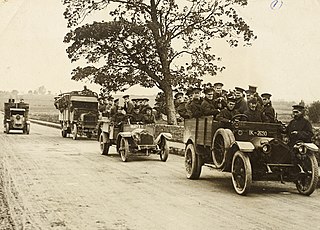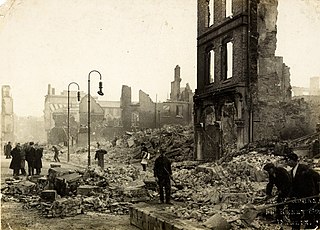
This is a timeline of the Irish War of Independence of 1919–21. The Irish War of Independence was a guerrilla conflict and most of the fighting was conducted on a small scale by the standards of conventional warfare.

The Kilmichael ambush was an attack carried out on 28 November 1920 by the Irish Republican Army (IRA) near the village of Kilmichael, County Cork, during the Irish War of Independence. Thirty-six local IRA volunteers commanded by Tom Barry killed sixteen members of the Royal Irish Constabulary's Auxiliary Division. The Kilmichael ambush was politically as well as militarily significant. It occurred one week after Bloody Sunday and marked an escalation in the IRA's campaign.
This is a timeline of the Irish Civil War, which took place between June 1922 and May 1923. It followed the Irish War of Independence (1919–1921), and accompanied the establishment of the Irish Free State as an entity independent from the United Kingdom of Great Britain and Ireland.
The Coolavokig ambush was carried out by the Irish Republican Army (IRA) on 25 February 1921, during the Irish War of Independence. It took place at Coolavokig, on the road between Macroom and Ballyvourney, County Cork. A 60-man flying column of the IRA's 1st Cork Brigade under Seán O'Hegarty, ambushed a 70-man convoy of the Auxiliary Division under Major Seafield Grant, sparking a four-hour battle. Ten Auxiliaries were killed, including Major Grant, and others wounded. The IRA column left the area when British reinforcements arrived. After the ambush, British forces stopped carrying out raids and patrols in the area.
The Scramoge ambush was an ambush carried out by the Irish Republican Army (IRA) on 23 March 1921, during the Irish War of Independence. The IRA ambushed a lorry carrying British troops and Royal Irish Constabulary (RIC) officers at Scramoge, near Strokestown in County Roscommon. Three British soldiers and an RIC officer were killed, while two RIC 'Black and Tans' were captured and shot dead shortly after.
The Battle of Ballinalee took place during the Irish War of Independence on 4 November 1920. Members of the Irish Republican Army (IRA), led by Seán Mac Eoin, drove a mixed group of Crown forces consisting of Black and Tans and Auxiliary Division personnel from the village of Ballinalee in County Longford.
The Clonfin Ambush was an ambush carried out by the Irish Republican Army (IRA) on 2 February 1921, during the Irish War of Independence. It took place in the townland of Clonfin between Ballinalee and Granard in County Longford. The IRA ambushed two lorries carrying members of the British Auxiliary Division, sparking a lengthy gun battle in which four Auxiliaries were killed and eight wounded. The Auxiliaries eventually surrendered and their weapons were seized. The IRA commander, Seán Mac Eoin, won some praise for helping the wounded Auxiliaries. Following the ambush, British forces burned a number of houses and farms in the area, and shot dead an elderly farmer.
The Sheemore ambush was an ambush carried out by the Irish Republican Army (IRA) on 4 March 1921, during the Irish War of Independence. It took place at Sheemore near Carrick-on-Shannon, County Leitrim.

Michael Kilroy was an Irish republican and politician. He was an Irish Republican Army (IRA) officer in his native County Mayo during the Irish War of Independence and Irish Civil War. Subsequently, he was a Sinn Féin and later Fianna Fáil Teachta Dála (TD) for Mayo South.

The burning of Cork, by British forces, took place during the Irish War of Independence on the night of 11–12 December 1920. It followed an Irish Republican Army (IRA) ambush of a British Auxiliary patrol in the city, which wounded twelve Auxiliaries, one fatally. In retaliation, the Auxiliaries, Black and Tans and British soldiers burned homes near the ambush site, before looting and burning numerous buildings in the centre of Cork, Ireland's third-biggest city. Many Irish civilians reported being beaten, shot at, and robbed by British forces. Firefighters testified that British forces hindered their attempts to tackle the blazes by intimidation, cutting their hoses and shooting at them. Two unarmed IRA volunteers were also shot dead at their home in the north of the city.
The Tooreen ambush was an ambush carried out by the Irish Republican Army (IRA) on 22 October 1920, during the Irish War of Independence. It took place near Roberts Farm, Tooreen, near Ballinhassig in County Cork. The IRA ambushed two lorries of British soldiers, killing three and wounding four others. The British surrendered and their weapons and ammunition were seized by the IRA. Later that night, British soldiers went on a rampage in nearby Bandon.
The Rineen ambush was an ambush carried out by the Mid Clare Brigade of the Irish Republican Army (IRA) on 22 September 1920, during the Irish War of Independence. The attack took place at Drummin Hill in the townland of Drummin, near the hamlet of Rineen, County Clare.
The Piltown Cross ambush was an action of the Irish Republican Army (IRA) during the Irish War of Independence. The attack on British forces took place on the night of 1 November 1920 near the village of Kinsalebeg, County Waterford. The site of the attack at the crossroads known as Piltown Cross was carefully chosen to give the attackers maximum tactical advantage.
Sean C. Finn was a commander of multiple units in the IRA's Irish War of Independence in the early 20th century. He led many attacks on the Black and Tans and the heavily armed RIC patrols, with his brigade usually armed only with shotguns.
The Kilmeena ambush was an action during the Irish War of Independence that took place at Kilmeena, County Mayo on 19 May 1921. The ambush ended in defeat for the local West Mayo Irish Republican Army (IRA), with five IRA volunteers killed and four wounded and captured. Two members of the Royal Irish Constabulary (RIC) and one Black and Tan were also killed in the action.
The Holywell ambush was an ambush on the Ballyhaunis to Claremorris road near Holywell in the early hours of Monday, 2 August 1920 carried out by the Irish Republican Army (IRA) during the Irish War of Independence. Approximately 20 local IRA volunteers commanded by Patrick Kenny attacked a British Military detachment that was guarding a broken down petrol lorry.

Thomas (Tom) Deignan was a Commandant of the Irish Republican Army in the Irish War of Independence, politician and veteran of World War I. He fought on the Anti-Treaty side in the Irish Civil War. After the war he entered local politics until his death.
The Rathcoole ambush was an ambush carried out by the Irish Republican Army (IRA) near the village of Rathcoole in County Cork on 16 June 1921 during the Irish War of Independence. Under the command of Paddy O'Brien, the IRA's 2nd Cork Brigade attacked an armed convoy of the Auxiliary Division returning to their barracks in Millstreet after collecting supplies. After 50 minutes of intense fighting, the IRA managed to inflict heavy casualties on the Auxiliaries before a shortage of ammunition forced them to withdraw. The Rathcoole ambush was one of the largest engagements of the war, and was the last major ambush to be carried out in the county.
The Drumcondra ambush was an attempted ambush carried out the Irish Republican Army (IRA) in Drumcondra, a suburb in northern Dublin, during the Irish War of Independence. On 21 January 1921, an IRA active service unit (ASU) initially set up an ambush near the Royal Canal in preparation for a British lorry which was travelling through the area. When the lorry failed to arrive, Frank Flood, the unit's commander, relocated his men up to a new position along the Tolka river. However, the IRA unit was spotted as they were setting up their new positions and a force of Auxiliaries was sent out, which resulted in 1 volunteer being killed and 5 others being arrested as they were attempting to escape.

The Killeeshil ambush took place on 15 July 1994, when an armour plated vehicle of the Royal Ulster Constabulary (RUC) was intercepted by a tipper lorry driven by a Provisional IRA active service unit from the East Tyrone Brigade and riddled with automatic rifle fire while travelling on the Dungannon Road at Killeeshil crossroads, in southern County Tyrone, Northern Ireland. Three members of the RUC were wounded, as well as a Sinn Fein councillor from Clones, Republic of Ireland, who by chance had been arrested earlier at the Irish border and was being transported to Belfast. An elderly female motorist was also wounded. The action occurred a few weeks before the IRA ceasefire of August 1994.






